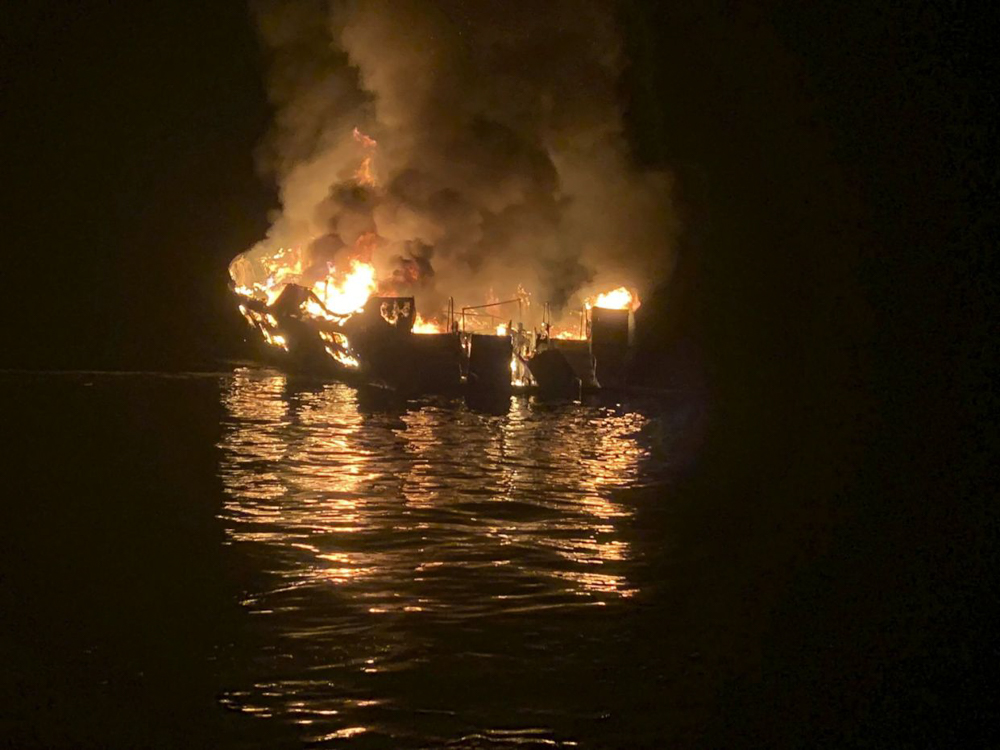Families Sue Truth Aquatics over ‘Conception’ Fire
Charge Lack of Night Watch and Safe Battery Charging Violated Regulations

At a press conference held on Monday in Santa Monica, attorneys for four victims of the Conception dive boat fire announced challenges to the shipowners’ effort to seek protection behind a pre-Civil War maritime law. The papers were filed on behalf of the families of crewmember Allie Kurtz, and divers/passengers Yulia Krashennaya of Berkeley, and husband-and-wife Kaustbh Nirmal and Sanjeeri Deopujari of Connecticut.
“The defendants killed these victims by breaking the law and failing to have a roving night watch whose job was to prevent the very catastrophe that occurred,” said Robert Mongeluzzi in a press release; he is a name partner in Saltz, Mongeluzzi, Barrett & Bendesky, a law firm based in Philadelphia that includes maritime law among its specialties. The documents, filed in the federal Central District Court for California with Santa Monica attorney firm Panish Shea & Boyle, allege Truth Aquatics, Glen Fritzler, and Dana Fritzler also violated Coast Guard regulations by failing to provide a safe means to store and charge lithium-ion batteries, widely used in underwater photography. The night before the fire, the passengers dove into the waters of the Channel Islands National Marine Sanctuary on a night dive.
Federal investigators have yet to conclude what caused the fire that killed 33 scuba divers and one crew member off the coast of Santa Cruz Island that Labor Day weekend, but the Coast Guard sent a bulletin a week later advising small passenger vessels to be aware of the fire danger of power strips and lithium-ion batteries, and to follow all regulations concerning emergency preparation, firefighting, lifesaving, and means of escape.
Panish attorney Robert Glassman said, “Through discovery, we intend to determine, for instance, why the Conception had noncompliant escape hatches in the event of an emergency, among what appears to be a litany of safety lapses.”
The National Transportation Safety Board team, during its investigation of the fire, commented how narrow the access was to an escape hatch above an upper bunk of the passenger sleeping quarters. Both the hatch and the stairwell opened into the galley, which is where cell phones, laptops, and the batteries for photo equipment and lights were charged, according to many who’d sailed aboard the Conception, and where the fire was burning out of control when the crew sleeping above woke up to it. The legal filings claim that the year before, a lithium-battery fire occurred on the Vision, a Truth ship very like the Conception.
The attorneys noted that the Fritzlers filed their Limitation of Liability claim “less than three full days” after the Conception fire horrified the dive world. “Rather than mourn those whose lives they took with their failure to obey the law,” said Mongeluzzi, “they lawyered up and mercilessly filed an action to limit their liability before many of the bodies of these victims were even recovered.”
The liability limitation dates to 1851 and has been used in disasters such as the sinking of the Titanic. In invoking it, the shipowners claim no dangerous flaws existed to cause the loss, thereby limiting their liability to the value of the ship. The Conception burned to the waterline early on the morning of September 2, and its loss is total. Further, the law requires any counterclaims to be filed within six months.
Mongeluzzi promised to hold the owners accountable and “demolish their frivolous limitation of liability claim.”
That lawsuit states the Conception was “tight, staunch, and seaworthy” for the trip. The Fritzlers’ attorney, Russell Brown of Gordon Rees Scully Mansukhani of San Diego, replied to a request for comment with a Memo of Points and Authorities in the Dignam case that stems from the fire. Such claims are “gratuitous hyperbole,” it states, and the 1851 rule is the “law of the land,” despite attempts to overturn it. Part of Brown’s argument was that for a small family business, 34 possible lawsuits, plus others by the surviving crew, is exactly what the ancient law meant to avoid. He also claimed the filing was premature, being lodged before the cause of the fire was determined, and mentioned the offer his clients made to extend the time to file an answer to the liability limitation claim to July 31, 2020, 20 days past the deadline. NTSB investigators, however, stated it would take 18-24 months to reach a conclusion.
Federal regulation of boats built before 1996 currently follow the rules at the time of construction. Santa Barbara’s U.S. Representative Salud Carbajal roundly criticized such rules during a House hearing in November, when he asked Coast Guard Rear Adm. Richard Timme why the rules did not include recent NTSB recommendations. During the hearing, Timme said that if the old rules were a causal factor in the disaster, new policies and rules would result.
The third set of counter-claims to the Fritzlers’ maritime liability action are actually four separate answers by the survivors of four who died on the Conception. The first counter-claim was by crewmember Ryan Sims, who claimed injuries against the shipowner and the dive organizer, Worldwide Diving Adventures. The second was by the survivors of Justin Dignam under similar allegations.
Though the NTSB investigation report and conclusion won’t be completed for another year, California legislators proposed stronger federal safety regulations for passenger vessels last month. Improved escape pathways, fire detection systems, and lithium-ion battery storage safety were emphasized.



